Diving into the depths of the ocean, a creature lurks in the shadows, its sinuous body weaving through coral reefs with deadly grace. Meet the enigmatic Moray Eel, an aquatic marvel that has captivated the imaginations of marine enthusiasts for centuries.
With its menacing appearance, powerful jaws, and secretive nature, the Moray Eel embodies both mystery and beauty, inviting us to explore the intriguing world that lies beneath the waves. Join us on an extraordinary journey as we unveil the untold secrets and fascinating adaptations of this remarkable predator, leaving you in awe of the mesmerizing Moray Eel.
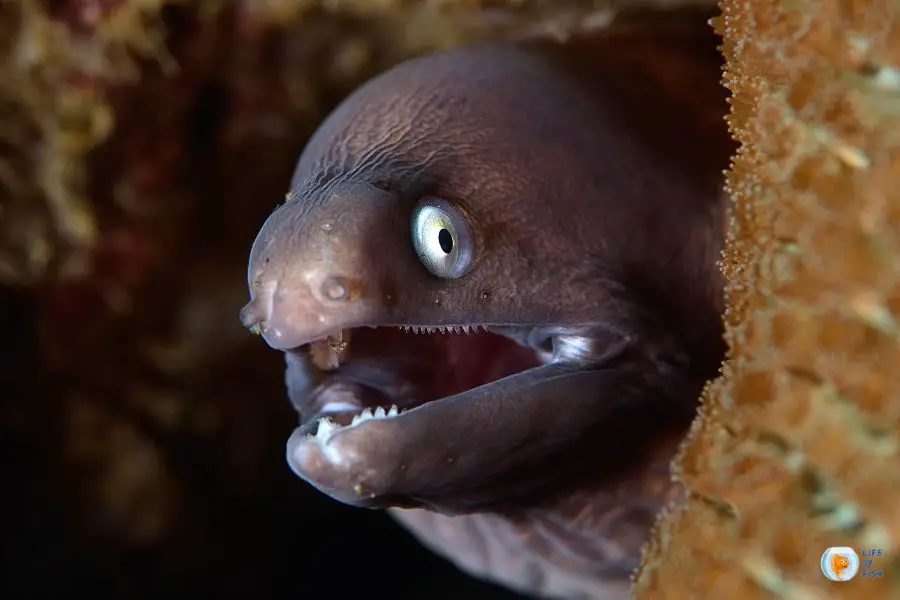
Is Moray eel a fish?
Yes, the moray eel is a fish. It is a species of fish that belongs to the family Muraenidae. Moray eels have long, slender bodies and it covers with smooth, scaleless skin. They can grow up to 13 feet in length and come in a variety of colors, including green, brown, and black.
Despite their fearsome appearance, moray eels are not aggressive towards humans unless provoked or threatened. They are carnivorous and primarily feed on smaller fish, crustaceans, and cephalopods. You can find them in tropical to temperate waters. And are often seen hiding in crevices or coral reefs.
Usually they are not a common target for commercial fishermen. But sometimes fishermen catch them unintentionally. Moray eels play an important role in marine ecosystems as predators and help regulate the populations of their prey.
Distribution and habitat
Jump To
- 1 Distribution and habitat
- 2 How can I prevent a moray eel bite?
- 3 what does moray eel eat?
- 4 do moray eels live in coral reef?
- 5 is moray eel poisonous?
- 6 are moray eels edible?
- 7 is moray eel electric?
- 8 are moray eels protected?
- 9 how do moray eels breathe?
- 10 can moray eels survive out of water?
- 11 do moray eels have 2 sets of jaws?
- 12 where do moray eels spawn
- 13 will moray eels attack you?
- 14 do moray eels like to be petted?
- 15 can moray eels live in freshwater?
- 16 can moray eels see?
- 17 how moray eels mate?
- 18 do moray eels eat octopus?
- 19 do moray eels eat sea urchins?
- 20 Conclusion
You can find them in tropical and subtropical waters around the world, including the Atlantic, Indian and Pacific Oceans. Although they prefer to live in shallow waters, you can also find them in deep waters as well.
They prefer to hide in crevices in coral reefs, under rocks, or in sandy bottoms waiting for their prey to pass by. Interestingly, there are more than 200 species of moray eels, ranging in size from just a few inches to over six feet long.
Their powerful swimming abilities and adaptive nature have made them successful predators in various environments.
How can I prevent a moray eel bite?
To prevent a moray eel bite, it is best to keep a safe distance when swimming or snorkeling in their habitat. Avoid touching or cornering the eel, as they can feel threatened and lash out in defense.
Also, be sure to wear protective gear such as gloves or a wetsuit to prevent skin abrasions. In the event of a moray eel encounter, remain calm and slowly back away from the eel. If a bite occurs, seek medical attention immediately as the saliva of these creatures can cause infections. It is important to respect the eel’s territory and not to provoke them as they play an important role in their ecosystem.
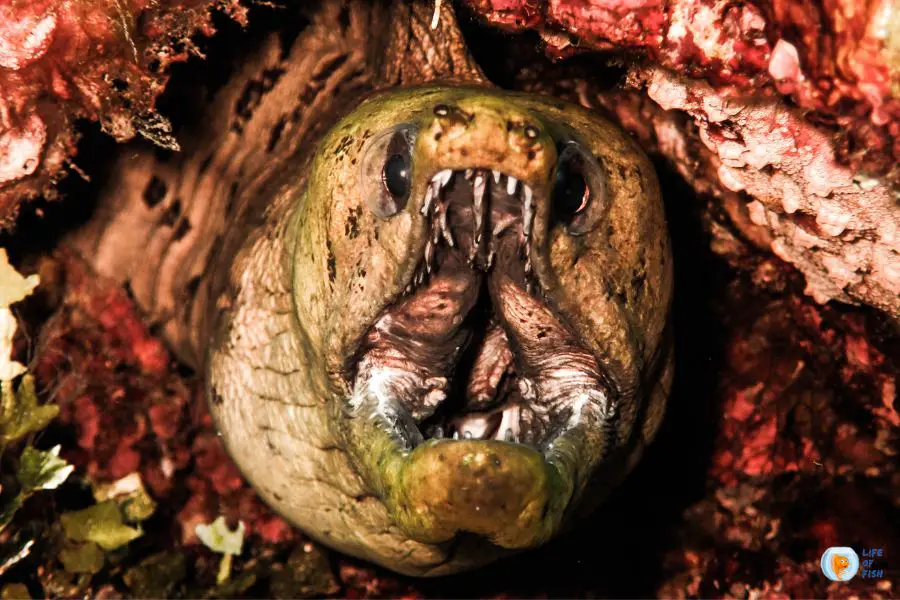
what does moray eel eat?
The moray eel is a carnivorous fish that mainly feeds on small fish and crustaceans. Their diet can vary depending on the species and the environment they live in. Larger species of moray eels can even prey on larger fish or squids.
They have very flexible jaws and can swallow prey whole or tear off bite-sized chunks. Moray eels have a strong sense of smell which helps them detect their prey, they also have keen eyesight and can hunt in low light conditions.
Some types of moray eels such as green moray eel engage in cooperative hunting with other species, such as groupers that help flush prey out of hiding places. Moray eels are nocturnal hunters and are most active at night.
They are ambush predators and will hide in crevices or under rocks waiting for prey to pass by. Moray eels are an important part of the marine ecosystem and help control populations of smaller fish and invertebrates.
Some species of moray eels are specialized hunters that have adapted to hunting in certain environments. For example, the starry moray eel hunt for shrimp and crabs in coral reefs. The leopard moray eel, on the other hand, is a skilled hunter that preys on fish and small octopuses.
Moray eels have a powerful set of jaws that they use to grab and crush their food. Despite their predatory nature, moray eels also have to be on the lookout for predators themselves. Young eels are often hunted by larger fish and sea birds, while adult eels may fall prey to sharks and barracudas.
do moray eels live in coral reef?
You can find Moray eels in coral reefs around the world. Moray eels are predatory animals that hunt for food in the cracks and crevices of the reef, using their keen senses of smell and sight to detect their prey.
is moray eel poisonous?
Moray eels are not poisonous, but some species of moray eels have a toxin in their skin and mucus that can cause an allergic reaction in humans if they come into contact with it. This toxin is not lethal, but it can cause symptoms such as itching, swelling, and redness in the affected area.
It is also important to note that moray eels have sharp teeth and can deliver a painful bite if they feel threatened or cornered. However, they are not venomous, which means that their bite does not contain any poisonous substances. If you encounter a moray eel while diving or snorkeling, it is important to give it a wide berth and avoid touching it.
are moray eels edible?
Moray eels are edible, but they are not very common in Western cuisine. They are associated with high levels of toxins. The toxin present in moray eel meat is called ciguatoxin. It can cause serious illness in humans if ingested in large quantities.
Some cultures, such as the inhabitants of the Pacific Islands, consume moray eels as part of their traditional diet, but they have developed methods to eliminate the toxins through curing, fermenting, or cooking the eels in a specific way. In Japan, Moray eels are considered a delicacy and consumed raw as sushi or sashimi.
They are also grilled, boiled in a hot pot, or cooked in a soup. However, consuming a moray eel harvested from polluted waters is dangerous. You can not remove toxins present in their bodies easily. It is important to ensure that the eel comes from a clean source before consumption.
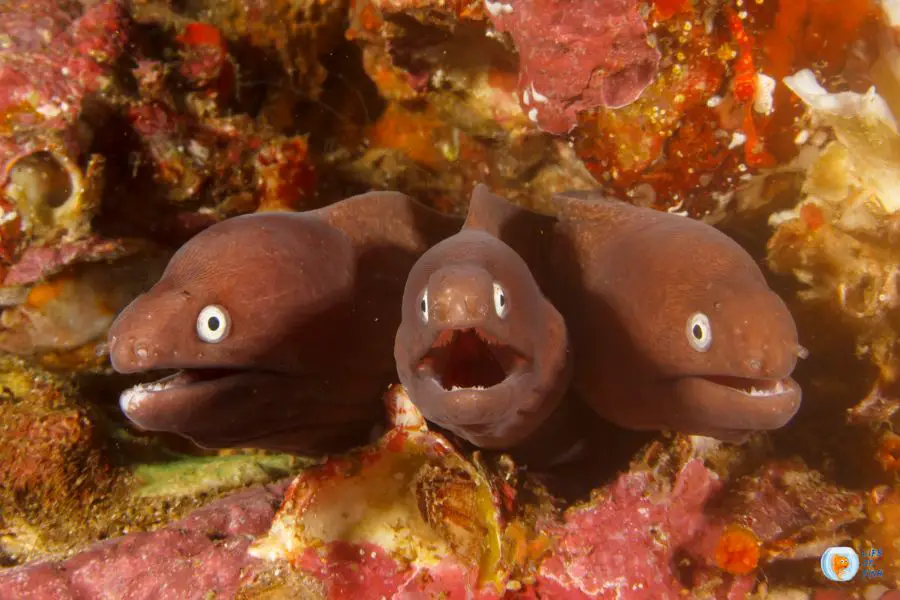
is moray eel electric?
Yes, moray eels are electric. They are able to generate electricity through special organs in their bodies that contain cells called electrocytes. These special organs allow them to produce an electric field and it is for communication, hunting and self-defense.
Electric fields generated by the eel’s organ also enable it to sense its immediate environment and detect any potential prey or predators nearby. This means they use electricity as a form of protection from danger and as a way to hunt food sources.
are moray eels protected?
Historically, these fish were heavily fished for both commercial and recreational purposes. This lack of protection caused their population numbers to drop drastically in certain areas.
However, with increased awareness about the importance of habitat conservation and environmental impacts due to climate change, more effort has been placed into protecting them. Conservation efforts have helped stabilize the population size of this species in some parts of the world.
Although they are not classified as an endangered species at this time. But active management plans should be put in place to avoid any negative effects from fishing or other human activities and to keep their habitats healthy.
how do moray eels breathe?
Moray eels have a unique respiratory system. It adapts to their environment and feeding habits. They are able to take in much more oxygen than other fish due to the gill anatomy of their species. Importantly, It contains larger openings than most common marine life. This allows them to absorb more oxygen from each breath they take.
Their breathing patterns also reflect their adaptations for increased oxygen intake. Moray eels typically open and close their mouths rapidly several times per minute when resting underwater. This action helps draw in large amounts of water. Therefore increases the amount of oxygen available to them at any given time.
Additionally, these animals do not rely as heavily on respiration during periods of activity or hunting prey. It allow them to conserve energy while still having access to enough oxygen.
can moray eels survive out of water?
It is possible for these creatures to survive out of water for an extended period of time. However how long this could be varies depending on the type of moray eel involved and environmental conditions such as air humidity levels.
do moray eels have 2 sets of jaws?
They possess two sets of jaws, which allow them to hunt and consume a wide variety of prey including fish, crab, squid, octopus and cuttlefish. They have an average lifespan ranging from 10-20 years depending on their species and size.
Moray eels use their sharp teeth to catch their food by surprise; they hide in coral reefs or crevices until it’s time to strike! What do moray eels eat? In addition to hunting for their own food, these carnivorous predators also scavenge for dead animals on the seafloor.
where do moray eels spawn
It’s important to note that different species of moray eel have varied spawning habits:
- Some will lay eggs in shallow waters during certain times of the year, such as the Mediterranean conger eel in European seas during late spring and early summer months;
- Others may demonstrate parental care for some period after hatching by defending egg beds from potential predators;
- Lastly, some prefer deeper habitats with adequate protection for their eggs until they hatch.
When considering all these details about particular species’ spawning behaviors, seasonality also plays a major role in determining location preferences among each individual species’ habitat selection when spawning.
will moray eels attack you?
Moray eels have a reputation for being aggressive predators and can often be seen lunging out of the water when fishermen are trying to catch them. This behavior is mostly due to their curious nature, as they investigate anything that moves in their environment; however, it doesn’t mean they will attack humans if given the chance.
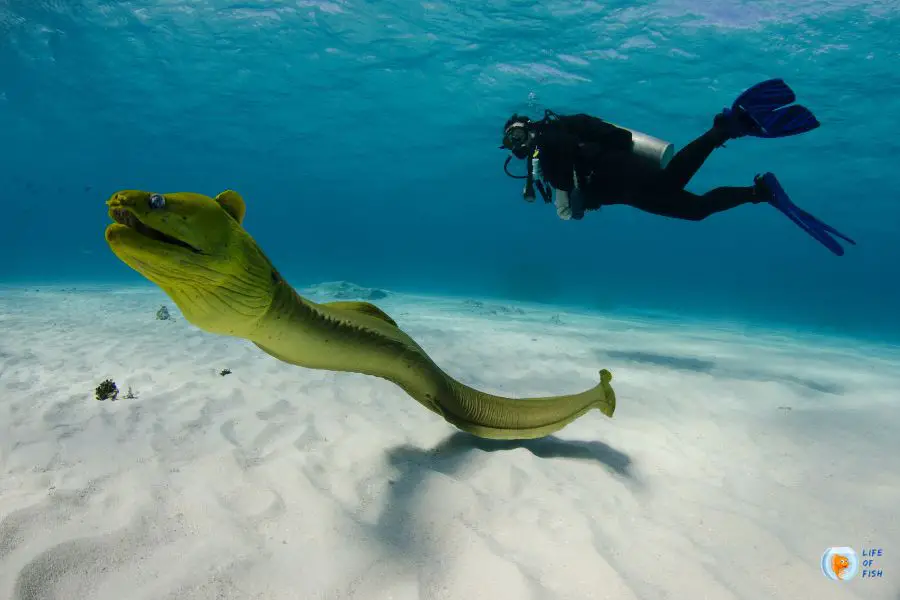
do moray eels like to be petted?
It is not recommended to try and pet or touch a moray eel, as they are wild animals and can be potentially dangerous. Moray eels have sharp teeth and a powerful bite, and they may perceive any attempt at touching or petting as a threat, which could result in injury to both the eel and the person attempting to touch it.
In addition, moray eels are not domesticated animals and are not accustomed to being touched by humans. Interfering with their natural behavior or habitat can cause stress or harm to the eel. Therefore, it is important to observe these creatures from a safe distance and avoid any interactions that could be harmful to both the eel and humans.
can moray eels live in freshwater?
Generally speaking, most species of moray eel prefer saltwater environments—but there are some exceptions!
Freshwater moray eels tend to stay close to shorelines where the water temperature and salinity levels more closely mirror their natural environment. What’s more, certain tanks may fit the needs of a freshwater moray depending on its size; however, careful attention must be paid to factors like filtration systems for optimal tank conditions.
can moray eels see?
Moray eels possess excellent eyesight which helps them survive in the wild by locating prey up to several feet away. An important adaptation that allows this species to be successful hunters is their ability to see well in low-light environments due to large pupils and an increased amount of rods in their retinas.
how moray eels mate?
Moray eels have a fascinating mating behavior which is deeply rooted in their social hierarchy. From courtship displays to breeding rituals, these creatures display various techniques for finding and courting mates based on the species’ habitat preferences.
When it comes to courtship displays, moray eels use both visual and acoustic cues with males typically being more aggressive than females. For example, they may perform head nodding or waving movements while simultaneously producing loud grunts or clicks.
Once a mate has been found, the two will engage in mating rituals such as circling each other or rubbing against one another.
It’s important to note that this type of behavior varies depending on the species of moray eel. As well as displaying different characteristics related to courtship and mating activities, some species also prefer different habitats when searching for potential mates:
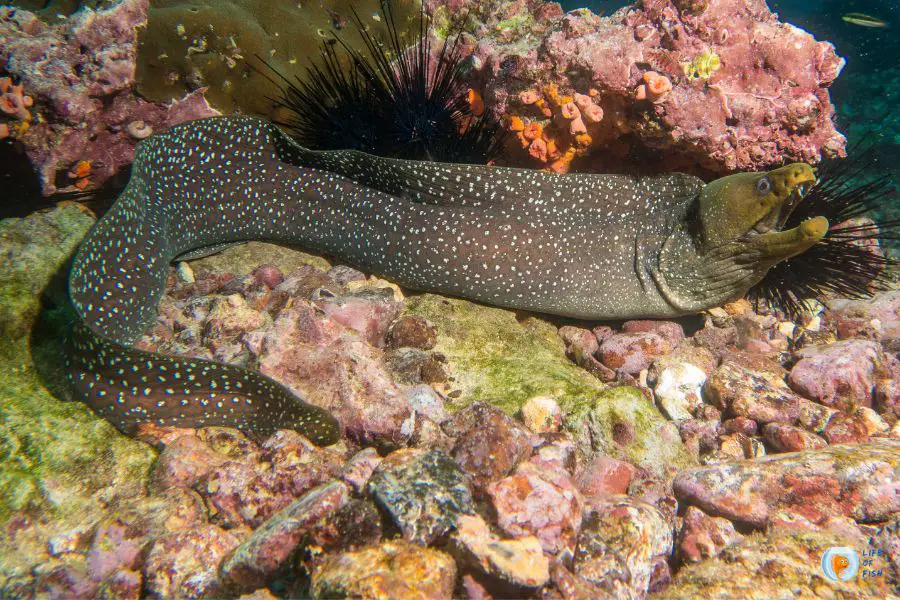
do moray eels eat octopus?
Moray eels are carnivorous predators that feast upon a variety of prey in the ocean, including octopuses!
They hunt by stealthily sneaking up on unsuspecting prey with lightning speed – an impressive feat given how fast some species of octopus can move!
But why do morays go after such difficult prey?
It turns out that octopuses make for a great source of nutrition, supplying them with essential vitamins and minerals needed for survival.
Plus, removing this predator from its ecosystem helps protect other sea life and keeps populations balanced.
do moray eels eat sea urchins?
Yes, moray eels do eat sea urchins! This is one of their primary diet preferences and they are known to consume them regularly.
Moray eels use their sharp teeth to catch prey such as crabs, shrimp, mollusks, octopus and squid. When targeting sea urchins specifically, they usually wait until an opening appears between the protective spines before attacking quickly and biting off small pieces of the fleshy parts inside.
All these facts make understanding its dietary needs both interesting and important in order to ensure proper care if you ever decide to keep one as a pet.
Conclusion
Moray eels are an incredible species. They have adapted to their environment in fascinating ways, making them one of the most interesting creatures living underwater. While they may appear intimidating and dangerous, these creatures remain a vital part of the marine ecosystem.
Knowing more about moray eel biology is key to understanding how we can protect this amazing species from environmental threats that could lead to its decline. With further research and conservation efforts, we will be able to ensure that future generations will continue to enjoy the beauty and wonder of moray eels for years to come.
Read Next: Peacock Eel (Macrognathus siamensis) | 12 Colorful Facts |
